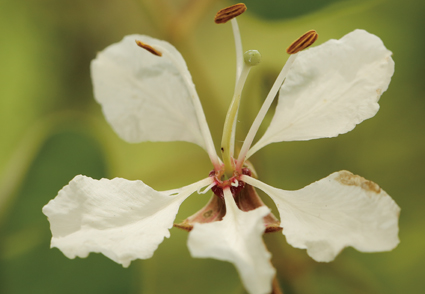Abstract
We describe here a rare, critically endangered new species of the genus Cheniella from Guangdong province of southern China. Cheniella tsoongii is morphologically similar to C. corymbosa, and can be distinguished by having a combination of deeply-bilobed hairy leaves, white flowers, shorter hypanthia, yellow anthers, and densely ferruginous-tomentose inflorescence rachides, pedicles and hypanthia. We suggest assessing the conservation status of the species as Critically Endangered (CR) as it possesses an extremely high risk of extinction based on the rapid population declines during the last century and, only no more than 10 individuals remain in an environmentally unprotected area now. Urgent conservation studies and actions are necessary to prevent the extinction of this species.
References
- Clark, R.P., Mackinder, B.A. & Banks, H. (2017) Cheniella gen. nov. (Leguminosae: Cercidoideae) from southern China, Indochina and Malesia. European Journal of Taxonomy 360: 1–37. https://doi.org/10.5852/ejt.2017.360
- de Candolle, A.P. (1825) Prodromus Systematis Naturalis Regni Vegetabilis 2. Sumptibus Sociorum Treuttel et Würtz, Parisii, 644 pp.
- de Loureiro, J. (1790) Flora Cochinchinensis 1. Typis, et expensis academicis, Ulyssipone, 394 pp.
- de Wit, H.C. (1956) A revision of Malaysian Bauhinieae. Reinwardtia 3: 381–539.
- Gagnepain, F. (1912) Bauhinia nouveaux d’Extrême-Orient. Notulae Systematicae 2 (6): 168–182.
- Gu, S.R., Zeng, Q.B., Clark, R.P., Jiang, K.W., Pérez-Escobar O.A., Li, S.J., Tan, W.N., Xie, Z., Mattapha, S., Shi, M.M., Wang, X.P., Zhao, Z.T., Antonelli, A., Tu, T.Y., Wen, J. & Zhang, D.X. (2024) Phylogeny and re-circumscription of Cheniella (Leguminosae: Cercidoideae) based on plastome data and morphology, with description of three new species. Taxon 73 (2): 475–502. https://doi.org/10.1002/tax.13177
- Hao, G., Zhang, D.X., Zhang, M.Y., Guo, L.X. & Li, S.J. (2003) Phylogenetics of Bauhinia subgenus Phanera (Leguminosae: Caesalpinioideae) based on ITS sequences of nuclear ribosomal DNA. Botanical Bulletin of Academia Sinica 44: 223–228.
- IUCN Standards and Petitions Committee (2022) Guidelines for Using the IUCN Red List Categories and Criteria, version 15.1. The Standards and Petitions Committee. Available from: https://www.iucnredlist.org/documents/RedListGuidelines.pdf (accessed 1 January 2024)
- Jiang, K.W., Gu, S.R., Li, S.J., Tu, T.Y. & Zhang, D.X. (2023) Three new combinations in the genus Phanera (Fabaceae: Cercidoideae) including the lectotypification of Bauhinia strychnifolia. Phytotaxa 584 (1): 52–54. https://doi.org/10.11646/phytotaxa.584.1.5
- Lewis, G.P. & Forest, F. (2005) Tribe Cercideae. In: Lewis, G., Schrire, B., Mackinder, B. & Lock, M. (Eds.) Legumes of the World. Royal Botanic Gardens, Kew, pp. 57–67.
- Linnaeus, C. (1753) Species Plantarum 1. Impensis Laurentii Salvii, Holmiae, 560 pp.
- Sinou, C., Forest, F., Lewis, G.P. & Bruneau, A. (2009) The genus Bauhinia s.l. (Leguminosae): a phylogeny based on the plastid trnL-trnF region. Botany 87: 947–960. https://doi.org/10.1139/B09-065
- Sinou, C., Cardinal-McTeague, W. & Bruneau, A. (2020) Testing generic limits in Cercidoideae (Leguminosae): Insights from plastid and duplicated nuclear gene sequences. Taxon 69 (1): 67–86. https://doi.org/10.1002/tax.12207
- Sun, W.B., Yang, J. & Dao, Z.L. (2019) Research and conservation of endangered wild plants with extremely small populations in Yunnan Province (1st ed.). Science Press, Beijing, 296 pp.
- Trethowan, L., Clark, R. & Mackinder, B. (2015) A synopsis of the neotropical genus Schnella (Cercideae: Caesalpinioideae: Leguminosae) including 12 new combinations. Phytotaxa 204 (4): 237–252. https://doi.org/10.11646/phytotaxa.204.4.1
- Wunderlin, R.P. (2010a) Reorganization of the Cercideae (Fabaceae: Caesalpinioideae). Phytoneuron 48: 1–5.
- Wunderlin, R.P. (2010b) New combinations in Schnella (Fabaceae: Caesalpinioideae: Cercideae). Phytoneuron 49: 1–5.
- Wunderlin, R.P., Larsen, K. & Larsen, S.S. (1987) Reorganization of the Cercideae (Fabaceae: Caesalpinioideae). Biologiske Skrifter, DetKongelige Danske Videnskabernes Selskab 28: 1–40.
- Zeng, Q.B. (2021) Species differentiation of Cheniella in Leguminosae. M.Sc. thesis. Guangxi University, Guangxi, China, 152 pp.


